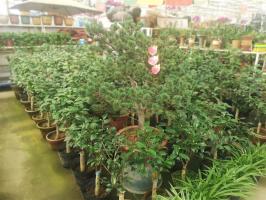Introduction
As a pond owner, you may be wondering whether you should leave your pond plants in pots or plant them directly into the ground. Both methods have their advantages and disadvantages, and it can be difficult to decide which one is best for your pond. In this article, we will examine the pros and cons of leaving pond plants in pots, and help you make an informed decision.
Advantages of Leaving Pond Plants in Pots
One of the main advantages of leaving pond plants in pots is that it allows you to easily move the plants around the pond. This can be particularly useful if you are redesigning your pond or if you want to create different zones within your pond. Potted plants can also be easily removed for maintenance or replanting.
Another advantage of leaving pond plants in pots is that it helps to control the growth of the plants. Some aquatic plants can become invasive and take over your pond, but when they are confined to pots, they are easier to manage. Potted plants also provide a physical barrier that can help prevent fish from eating the roots of the plants.
Disadvantages of Leaving Pond Plants in Pots
One of the main disadvantages of leaving pond plants in pots is that it can be more expensive than planting them directly into the ground. You will need to purchase the pots, soil, and fertilizer, which can add up over time. Additionally, some plants may outgrow their pots and need to be replanted into larger containers, which can be time-consuming and costly.
Another disadvantage of leaving pond plants in pots is that it can be difficult to achieve a natural look. Potted plants can look artificial and out of place in a naturalistic pond. Additionally, the pots themselves can be an eyesore if they are not well-hidden.
Tips for Leaving Pond Plants in Pots
If you decide to leave your pond plants in pots, there are a few tips that can help you achieve the best results. First, choose pots that are large enough to accommodate the plant’s root system. Smaller pots will restrict growth and can cause the plant to become root-bound.
Second, use a high-quality soil that is specifically formulated for aquatic plants. Avoid using garden soil, which can be too heavy and can cause the plant to sink into the pond.
Lastly, fertilize your potted plants regularly to promote healthy growth. There are many different fertilizers available for aquatic plants, so be sure to choose one that is appropriate for your particular plant species.
Conclusion
In conclusion, leaving pond plants in pots has its advantages and disadvantages. Ultimately, the decision comes down to your personal preferences and the needs of your pond. Whether you choose to plant your pond plants directly into the ground or leave them in pots, be sure to provide them with the proper care and maintenance they need to thrive.

 how many times do yo...
how many times do yo... how many planted tre...
how many planted tre... how many pine trees ...
how many pine trees ... how many pecan trees...
how many pecan trees... how many plants comp...
how many plants comp... how many plants can ...
how many plants can ... how many plants and ...
how many plants and ... how many pepper plan...
how many pepper plan...
































